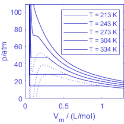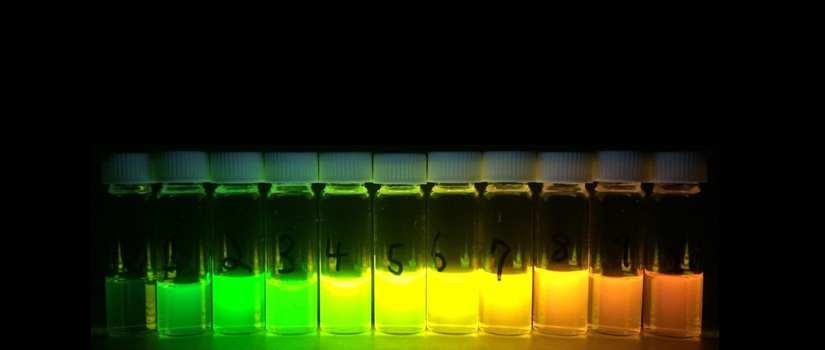Andrew B. Greytak Group Site
Experimental physical and materials chemistry, with a focus on nanocrystal surfaces.
Our lab explores the formation, physical properties, and interfacial chemistry of
nanoscale materials. Materials that we make in our lab include nanocrystal quantum
dots (QDs) superparamagnetic oxide nanocrystals; we also examine a variety of other
low-dimensional materials in collaborative projects. A strong inspiration for this
work is the opportunity to impact fields including energy conversion, energy storage,
bioimaging, and biomedicine.
There are two general themes that guide our choice of problems. One is an attempt
to develop surface-sensitive metrics, purification strategies, and synthetic steps
for QDs and other colloidal nanocrystals that permit increasingly precise and sophisticated
control of the resulting physical and chemical properties. Such control is necessary
for improving the performance of QD solar cells and other nanocrystal-based devices,
and for advancing the biomedical applications of nanocrystal-based imaging and therapeutic
agents. The second concerns the transport of matter, charge, and energy within nanoscale
systems and across interfaces. We use microfabrication, optoelectronic measurements,
and functional imaging techniques to characterize these transport processes. These
themes are explored in several project areas.
Graduate and undergraduate students with a variety of academic interests including
physical, inorganic, and organic chemistry; physics; biological sciences; and electrical
engineering will be able to make strong contributions to the group’s research. Group
members employ techniques including air-free synthetic chemistry, NMR spectroscopy,
calorimetry, chemical vapor deposition, scanning and transmission electron microscopy,
microfabrication, and photoluminescence imaging and spectroscopy. Instrument control,
data analysis, and technical image analysis is done with computational tools such
as Matlab and Image-J.
Undergraduates interested in research opportunities should contact Prof. Greytak directly
with a CV and a note regarding your professional goals. Prospective graduate students
are advised to consult the Department’s graduate admissions page
News and Highlights

Chemistry & Biochemistry OPEN HOUSE for high school chemistry students: Dec 6, 2025
[PDF flyer]
Come see world-class teaching and research facilities & talk to practicing chemists!
Open to high school students and teachers. Program begins at 2:00 pm (please arrive
early) -- click for flyer with complete info!

Nanoscience course Fall 2025
Prof. Greytak's Nanoscience course returns Fall 2025 as Chem 649 / 749 -- this serves
as a Physical Chemistry core course for Chemistry PhD students, but is also a good
introduction to solid state and materials chemistry, analytical techniques, and recent
literature for Chemistry undergrads and for graduate students across physics, chemistry,
and engineering disciplines! More on the Academics page.

Announcing Greytak-Chemistry-Lab GitHub site and Matlab Tutorial for Chemists
We're on GitHub! We use Matlab a lot for data analysis -- to help people get started,
Andrew Greytak has developed a "chemists tutorial" for Matlab, learning to use Matlab
to plot data, do matrix math and curve fitting, and analyze images, with examples
from physical chemistry! You can try it out. A portion was presented as part of the
Department of Chemistry and Biochemistry's "ChemCamp" tutorial seminar series, along
with Morgan Stefik. More of our projects will be shared in the future!

Constructing Lead Halide Perovskite Nanocrystal Surfaces -- Focus Review in ACS Energy
Letters
Halide perovskite quantum dots can be amazingly bright emitters, but their surface
chemistry is very important! What are some ways effective lead halide perovskite surfaces
can be put together? Jennii, Bishal, and Sakiru assembled a Focus Review, now out
in ACS Energy Letters, looking at native surface termination, exchange of coordinating
ligands, and reactive chemistry approaches! Link to ACS Energy Letters.

Chemistry, Light, and Color at the South Carolina State Museum
We visited the awesome summer camp program at the South Carolina State Museum twice
this summer to share our enthusiasm for chemistry, light, and color, making things
bubble and glow! We've re-built our "dot box" display to show off fluorescent materials,
check out the spectrum of different light sources, and we even had some quantum dots
in glass to pass around. Great questions from the kids!

Jolina Deng wins Best Poster Award at 2025 USC ACS SEED symposium
Jolina (Cet) Deng joined our lab for 8 weeks this summer through USC's ACS SEED program.
She studied purification techniques for magnetite iron oxide nanocrystals in aqueous
solutions, working with Jennii, and impressed the judges with her description of her
work at the concluding symposium. Best of luck to Cet for her senior year at Spring
Valley High School!

Congratulations Gryphon on ACIN Best Poster Award
Dr. Gryphon Drake was one of the inaugural winners of the Poster Award at the (awesome!)
American Conference on Inorganic Nanocrystals at Mt. Snow, Vermont this July, for
his work on nanocrystal precursor chemistry, supported by the NSF Division of Chemistry.

ITC measurement of uranium & thorium uptake in MOF
Jennii Burrell's collaboration with the Shustova lab, detecting coordination of actinide
cations by a photoswitchable metal-organic framework via isothermal titration calorimetry,
has been published in Chemical Science! Congrats to Kyoungchul Park and the whole
Shustova lab team for accomplishing this work!

Discover USC 2025
Moinul, Jennii, and Camilla presented their work at the 2025 Discover USC conference
at the Columbia Metropolitan Convention Center.

Camilla Awarded Magellan Scholar Grant
Camilla Morgan was awarded a prestigious Magellan Scholar Grant from the USC Office
of Undergraduate Research for her research project on purification of superparamagnetic
nanocrystals.

URI students making waves
The College of Arts and Sciences First Year Undergraduate Research Initiative, led
by Profs. Simoska, Hosseini, and Fountain, puts first-year Chemistry and Biochemistry
majors on the fast track to independent research by building common lab skills in
chemistry prep and spectroscopy, and then linking them up with projects in participating
research labs like ours. Veby Youssef, Camilla Morgan, and Connor Dow joined our lab
this Spring with Jennii Burrell and Moinul Islam as mentors. Here’s our excitation-emission
setup: some assembly required!

Welcome Farjana and Nuwandi
First-year Chemistry graduate students Farjana H. Mitu and Nuwandi K. Jayasekara have
joined the lab!

Group trip to One Eared Cow Glass
Quantum Dots were first explored as pigments in glass, so we took a group trip to
One Eared Cow Glass here in Columbia to learn about the other kind of glassware and
some of the chemistry inside it!

2023 Nobel Prize in Chemistry awarded for Quantum Dots
Congratulations to Alexei Ekimov, Louis Brus, and Moungi Bawendi … and the work of
the many colleagues, students, and entrepreneurs who have helped to demonstrate the
beauty and significance of these tiny, shiny crystals! An excellent history of quantum
dots is described in this Nano Letters perspective by Brus and Alexander Efros:

Welcome to Dr. Gryphon Drake
Gryphon joined the College of Arts and Sciences as a postdoctoral associate in July
2023, having completed his PhD at the University of Illinois with Prof. Moonsub Shim.
He will be conducting research on semiconductor nanocrystal ligand exchange chemistry,
and also teaching Chem 141M in Spring 2024.















